Bicycle commuting, and using a bicycle as one’s main mode of transportation in general, is an interesting thing. Before starting to do it on a regular basis, it seemed so mysterious. How does one handle rain? Snow? What about transporting large or oddly-shaped objects? What about really hot weather? Do you shower when you arrive?
And then there’s traffic. What about riding on city streets? Where the cars are? People have major misconceptions about how to safely ride a bike on roads. The correct methods that I see violated frequently basically involve “vehicular cycling” — driving your bike like you would car. Don’t ride on sidewalks. Don’t go the wrong way on one-way streets. Don’t ride on the left-hand side of the road (against traffic). These things don’t make you safer. They make you more likely to die. Don’t ride too close to parked cars lest you get “doored”.
The absolute safest thing you can do, if you can keep up, is to ride right smack dab in the middle of traffic, like a car or moped. This is hard when going uphill. Then, it’s best to find a street with a lot of room and not too much traffic, because you won’t be fast. Going downhill is another story. I have clocked 27 miles per hour (GPS-tracked) on my commuting bike and 47 miles per hour on my road bike (on different hills, mind you). 27 MPH is plenty for the city, and 47 could get you a speeding ticket (ostensibly). 27 is pretty fast for the commuter bike, though. It’s hard to go that fast. The road bike on the other hand has higher gearing and is lighter. It also has drop handlebars that encourage and support lower-drag riding positions. These are the handlebars that used to be on my commuting bike:
They afford a very comfortable riding position that’s good for visibility (i.e. uprightish). However, that puts your whole body in the way of the wind. It’s better to be leaned forward with your torso nearly horizontal. Therefore, I have wanted for probably 8 months to put drop bars on my commuting bike. This is no small order though. It requires different shifters, different brake levers, different cable lengths, different handlebars (obviously), and a bunch of knowledge on how to reconfigure things that I previously lacked.
The handlebars were easy. There are probably 100 sets or more at the bike project where I volunteer. The combined brake/shifter devices that I prefer to use with drop handlebars are not so easy to come by. New, they generally exceed $100. I didn’t want to fork out for that in case I found that the changeover didn’t work out. Luckily, 3 or 4 months ago I was able to sift through the parts at the bike shop and find a pair that matched the gearing on my bike. I purchased them with my accumulated shop credit from volunteering (all of it over 3 requisite hours per month), and then they sat in my house while I waited to order the remaining equipment necessary. I finally got it just after the holidays.
After three harrowing hours at Velocipede, it is done. Here’s the profile view of the bike:
And front and side views of the bars closer up:
The position of the handlebars and the shifters took some tweaking. I realigned it all four times before being satisfied. I also had to adjust the saddle position. Finally, since I had to re-cable the whole bike, I decided to do a nicer job than the people at the shop who originally put it together. The cable ends used to be too long, and were sloppily curled around to stay out of the way. I cropped them close and bent them neatly out of the way with needle-nose pliers. Observe:
With that I think I’ve now learned how to do most things to a bike, old or modern. I guess I’ve got another fall-back if the current career plan doesn’t work out.
The whole flickr set, most of which is already posted here, is located here.
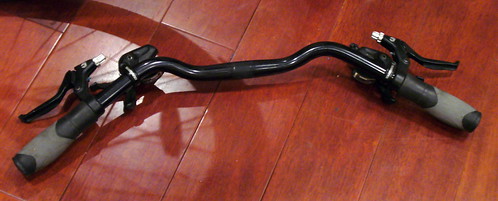
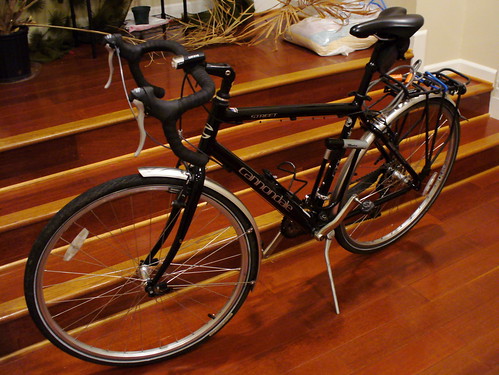
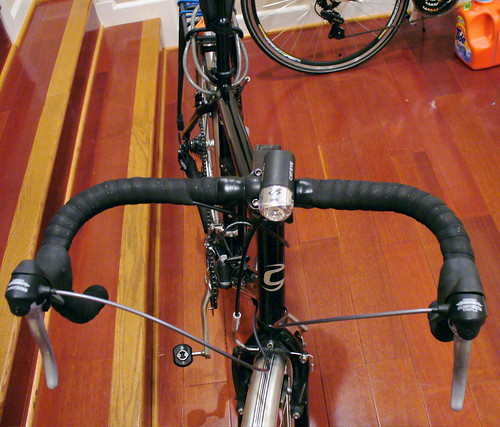
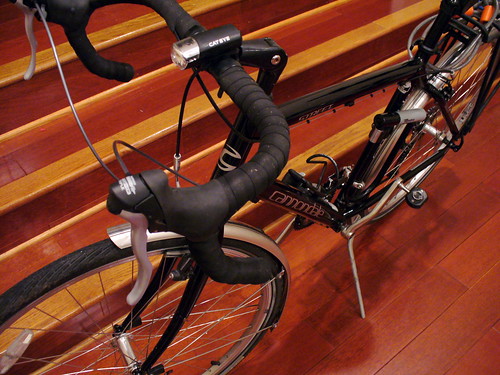
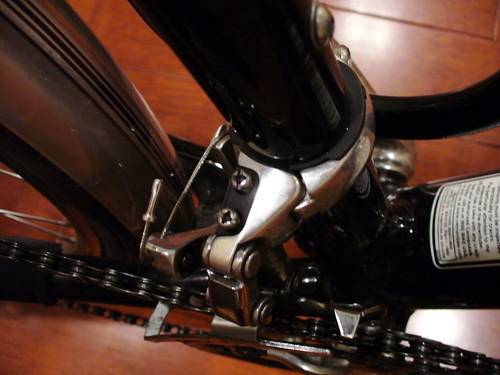
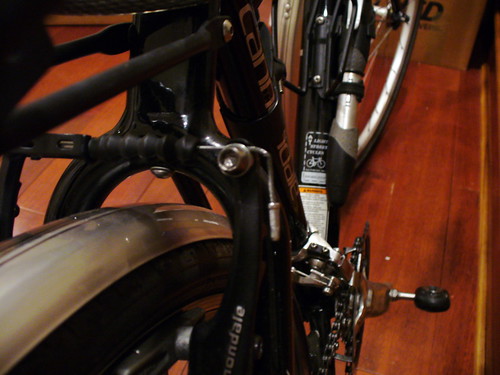
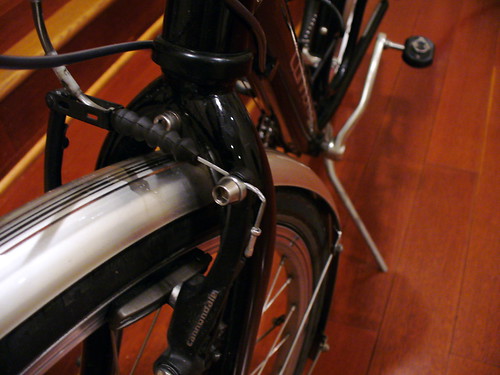
Nice – that live down here or up there?
Thanks!
That one lives in Baltimore. I have a mountain bike with smooth tires and fenders for my time in New Orleans. My true road bike is up here in Baltimore.
I can appreciate your curiosity about commuting via bike. I went through a very similar set of feelings when I was first starting to commute with human-power. I commute everywhere via bike and I live on the Oregon coast. Because of where I live, I cannot speak on your question about biking in heat, but I am definitely an authority as to biking in the rain.
Even in colder weather, one needs to focus on the breathability of garments. Your choice here is to get wet from the outside (with rain), or to get wet from the inside (with sweat). I cannot stress breathability enough, unfortunately breathable waterproof fabric is spendy.
With price taking priority, I have opted to go cheap and get something which is treated with PVC, but my jacket has pit-zips and mesh pockets I can open to let sweat vapors out. For pants, tights have worked best for me. You can use Under Armour or you can spring for bike tights. Also, you may want to get some shoe covers.
One option is a rack and/or basket to carry groceries. If you are talking about heavier, larger, or more awkward items, I have seen people use trailers with good reports.
For my daily commute, I have opted to just wear flip-flops (the cheapest waterproof shoe sold), tights or water-resistant pants, and that cheapo PVC jacket with zippered vents. The flip-flops fit well with my Look pedals on the clip-in side, and I pack a change of clothes so I don’t have to wear tights or soaked waterproof pants all day.
Anyway, I hope you enjoy your adventures as a bike commuter. Just stick with it; it’s worth it.